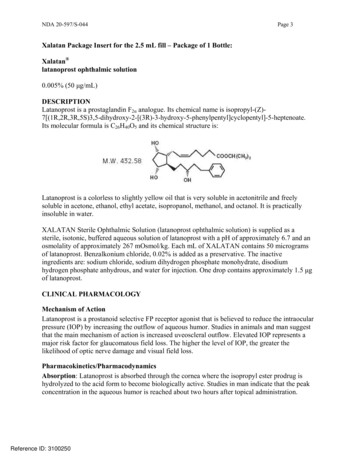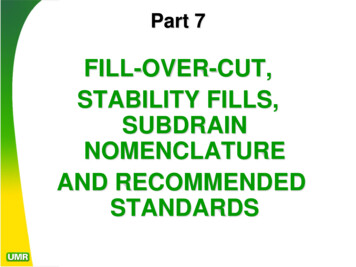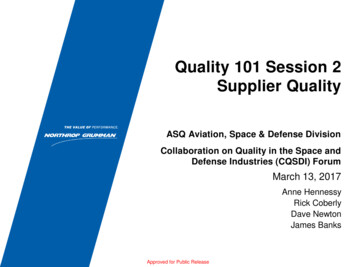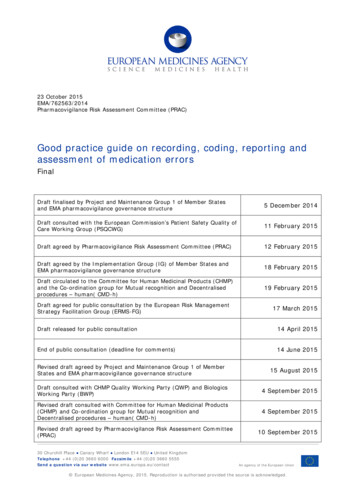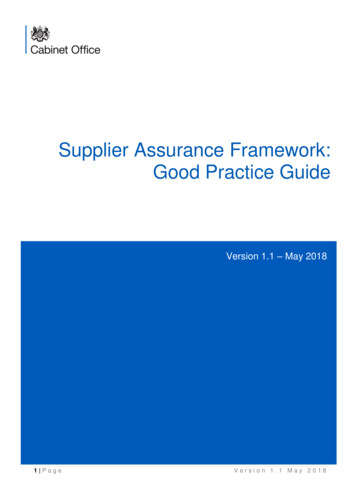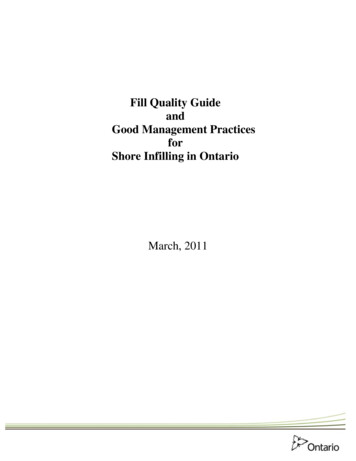
Transcription
Fill Quality GuideandGood Management PracticesforShore Infilling in OntarioMarch, 2011
Fill Quality GuideandGood Management PracticesforShore Infilling in OntarioRevised in 2011 by M. Gordon and T. FletcherStandards Development BranchOntario Ministry of the EnvironmentCette publication technique n'est disponsible qu'en anglais.Copyright: Queen's Printer for Ontario, 2003This publication may be reproduced for non-commercial purposes with appropriateattribution.Printed on recycled paperISBN 0-7729-9329-7PIBs 8317
Fill Quality Guide and Good Management Practices for Shore Infilling in OntarioTable of ContentsAcknowledgments. 2Executive Summary . iForeword . iv1.0Introduction. 11.1Shore infilling in Ontario - Background . 12.0Fill Quality Guide . 33.0Use of this Guide and Good Management Practices . 33.14.0Types of projects where this Guide and Good Management Practices are useful. 4Good Management Practices for Fill Placement . 54.1General Conditions . 54.2Siting and Some Design Considerations. 65.0Good Management Practices environmental criteria. 75.1General. 75.2Fill Quality Evaluation. 85.2.1Confined Fill Material Criteria . 95.2.2Unconfined Fill Material Criteria . 105.2.3Rationale - Chemical Effects . 135.3Physical Effects. 145.3.1Turbidity Criteria . 145.3.2Rationale - Turbidity. 145.3.3Sedimentation Criteria . 155.3.4Rationale – Sedimentation . 15
Fill Quality Guide and Good Management Practices for Shore Infilling in OntarioReferences. 17Appendix A: Origin of the Provincial Guide and Good Management Practices, and ofrelationships with the management of surplus terrestrial fill . 24Appendix B: Legislative requirements and approval processes . 27Appendix C: Fill Quality Guides . 31Appendix D:. 38List of TablesTable C-1: Confined Fill Guide Parameter List. 32Table C-2: Unconfined fill Guide Parameter List. 36List of FiguresFigure D-1: Categorization of Fill for Lakefilling. 38Figure D-2: Site Specific Sediment Criteria for Organic Compounds . 39Figure D-3: Site Specific Sediment Criteria for Other Parameters. 405
Fill Quality Guide and Good Management Practices for Shore Infilling in OntarioExecutive SummaryThe Management GoalThe management goal of the Ontario Fill Quality Guide (Guide) and the GoodManagement Practices for Shore-infilling in Ontario (Good Management Practices) is toprotect aquatic ecosystems by protecting theDEFINITION: Shore infillingquality of the sediment and water in areasadjacent to shore-infilling activities.Shore infilling is the practice ofThe need for such a goal was demonstratedbecause monitoring of some existing shore fillingsites suggested that in some cases the quality offill used degraded the quality of the water andsediment, and had deleterious effects on aquaticorganisms.Fill Quality Guidecreating new land by placing rubble,stones, concrete, brick and looseearth into shallow areas in lakes andrivers. Shore filling may beundertaken to protect shores fromerosion or floods and to create landfor parks, marinas and wildlifepreserves.Contaminated fill should not be placed in water along a shore or bank or adjacent towater along a shore or bank. Materials placed behind impermeable barriers on the shoreor bank that can withstand a one-in-one hundred year storm are not subject to the FillQuality Guide.Fill Quality Good Management PracticesGood management practices explain how contaminated and uncontaminated fill can beidentified, and also suggest how each can be managed.A brief history of fill-quality good management practicesFrom 1976 to 1992, the quality of fill to be placed directly into the water was evaluatedagainst criteria outlined in the Ontario Ministry of the Environment 1976 Open WaterDisposal Guidelines for dredged sediment (originally Section 12 in: Persaud and Wilkins,1976, and thereafter in several subsequent manuscript updates e.g. Appendices A – C inEnvironment Canada and the Ontario Ministry of the Environment, 1982). Theseguidelines were developed to determine whether dredged material was suitable fordisposal in open water, and they were also used to evaluate potential fill of terrestrialorigin. In 1992 the first version of this text, then entitled Fill Quality Guidelines forLakefilling in Ontario - Application of Sediment and Water Quality Guidelines toLakefilling, replaced the use of the Open Water Disposal Guidelines.The accompanying Good Management Practices describe the quality of the fill whichmay be used in shore infill projects. This Guide and the related Good ManagementPractices, together with the Provincial Sediment Quality Guidelines (in Appendices - seeFletcher et al, 2008 for explanation) will provide enhanced protection of the aquaticenvironment. See Appendix A for detailed information.i
Fill Quality Guide and Good Management Practices for Shore Infilling in OntarioShore-infilling is regulated by Provincial, Federal, Municipal and other AgenciesUse of this Fill Quality Guide and the Good Management Practices is voluntary. TheOntario Ministry of the Environment has no approval role in shoreline management – theintent of this guide is to suggest to other agencies and proponents ways of assessing thesuitability of the quality of fill so that the management goal of protecting aquaticecosystems is attainable.Shore-infilling activities can be subject to requirements of provincial, federal, andmunicipal legislation and regulations, and related policies – and to legal requirements ofagencies such as Conservation Authorities. Proponents of shore infilling and regulatoryagencies may choose to use this Guide and Good Management Practices as an aid whendeciding what attributes best describe clean fill. A partial listing of some pertinentProvincial, Federal legislation and regulations and municipal by-laws can be found inAppendix B.Summary of good management practicesConfined fill may be used when placed within the confines of a structure, such as a dyke,which is capable of withstanding the waves of aDEFINITION: Fill typesone-in-one hundred years storm. The intent ofMaterial which may be used for shoreconfinement is to prevent the fill from cominginfilling projects, is divided into twointo contact with the open water and, in the eventcategories – contaminated orof a storm or high waves, being washed away.uncontaminated. To achieve theenvironmental management goal,Placing contaminated fill on a one-in-one hundredcontaminated fill must be confinedyear floodplain of a stream or river system is alsowhereas uncontaminated fill does notnot considered to be a good practice, despiterequire confinement.confinement, due in part to threats to theThroughout this document, reflectingconfinement structure arising from flood currents,Good Management Practices,and/or the effects of ice scour and catastrophicuncontaminated material is calledeffects of ice dam failure or removal, and to theunconfined fill and contaminated fill isconsequent potential for significant downstreamcalled confined fill.dispersion of contaminants should failure of aconfinement structure occur, and to the greater potential for significant unwanted aquaticeffects and effects on downstream users. Placing uncontaminated fill into flowing watersuch as streams and rivers requires technical knowledge of fluvial geomorphology andaquatic habitat (e.g. see Ministry of Natural Resources, 2002) and is an activity regulatedby a number of agencies.Unconfined fill may be placed directly into open water.A series of stringent tests is used to determine whether fill can be consideredcontaminated or not. These include: bulk chemical tests for 8 metals and organic compounds includingpolychlorinated biphenyls (PCBs), arsenic, cadmium, chromium, copper, lead,ii
Fill Quality Guide and Good Management Practices for Shore Infilling in Ontariomercury, nickel, zinc, total organic carbon and total phosphorus. a Receiving Water Simulation Testwhich determines whether or notorganic compounds, such as PCBs,leach from the fill.further tests which may be requestedby a regulatory agency on a case bycase basis. The tests may includeadditional chemical analyses fornutrients, other metals, and organiccompounds listed in the ProvincialSediment Quality Guidelines (seeFletcher et. al., 2008(a)).DEFINITIONSBackground concentration: Thischemically describes the quality of thesediment before it was affected byhuman activity.Lowest Effect Level: This is the levelof contamination in the sediment atwhich testing shows there is no toxiceffect on the majority of sedimentdwelling organisms.Uncontaminated fill which can be used in an unconfined manner also satisfies the LowestEffect Level of the Provincial Sediment Quality Guidelines for organic parameters andeither the Lowest Effect Level or the background level of the sediment for metals and fororganics (Tables 3 and 4 in Fletcher et. al., 2008(a)). Unconfined fill is also free ofsubstances which could bioaccumulate in organisms and of substances which could formobjectionable deposits - such as scum - or degrade the potential of the water forrecreation or as a habitat for aquatic life.Under the Good Management Practices, fill which fails the tests for Unconfined Fill mayqualify as Confined Fill if it meets the requirements for Confined Fill. Material that failsthe requirements for Confined Fill should not be used for shore infilling and should bemanaged in accordance with other policies (e.g. municipal policies such as MacMillanand Crowther, 2005) and applicable procedures developed to address the movement ordisposal of excess soil such as Regulation 347 General - Waste Management /elaws regs 900347 e.htm ).While the shore infilling project is being built, all reasonable measures should be taken tominimize turbidity and to reduce the loss of fill. Precautions may include placing fillonly during calm/low flow periods and/or protecting all exposed areas of the shore infillproject from severe storms by dykes and enclosures to prevent erosion.iii
Fill Quality Guide and Good Management Practices for Shore Infilling in OntarioForewordThis Guide and Good Management Practices are intended to aid users in evaluating thesuitability of fill material for shore-infilling. The Good Management Practices aredesigned to help protect the aquatic environment from the physical effects of infill, andfrom contaminants associated with shore infill materials1.Although this Guide and Good Management Practices may assist proponents andregulators in determining whether or not a proposal may result in unwantedenvironmental effects, use of this Guide and Good Management Practices does notexempt proponents of proposed projects from current evaluation procedures or approvalrequirements under legislation administered by the Ministry of the Environment, or byother Ministries or agencies. Proponents are responsible for complying with all pertinentlaws and conforming with pertinent policies; federal, provincial, and/or municipal.The Good Management Practices incorporate features of the Provincial Sediment QualityGuidelines (Fletcher et al, 2008(a)) to ensure protection of sediment and the ProvincialWater Quality Objectives (Ontario Ministry of the Environment and Energy, 1994) toensure protection of water quality and water uses. Some provisions in this documentrelating to the suitability of fill material for shore infilling, specifically the use of criteriain the Confined fill management practices, contain references to material in the Ministrypublicatio
Shore infilling is the practice of creating new land by placing rubble, stones, concrete, brick and loose earth into shallow areas in lakes and rivers. Shore filling may be undertaken to protect shores from erosion or floods and to create land for parks, marinas and wildlife preserves. Executive Summary The Management Goal The management goal of the Ontario Fill Quality Guide (Guide) and the .
